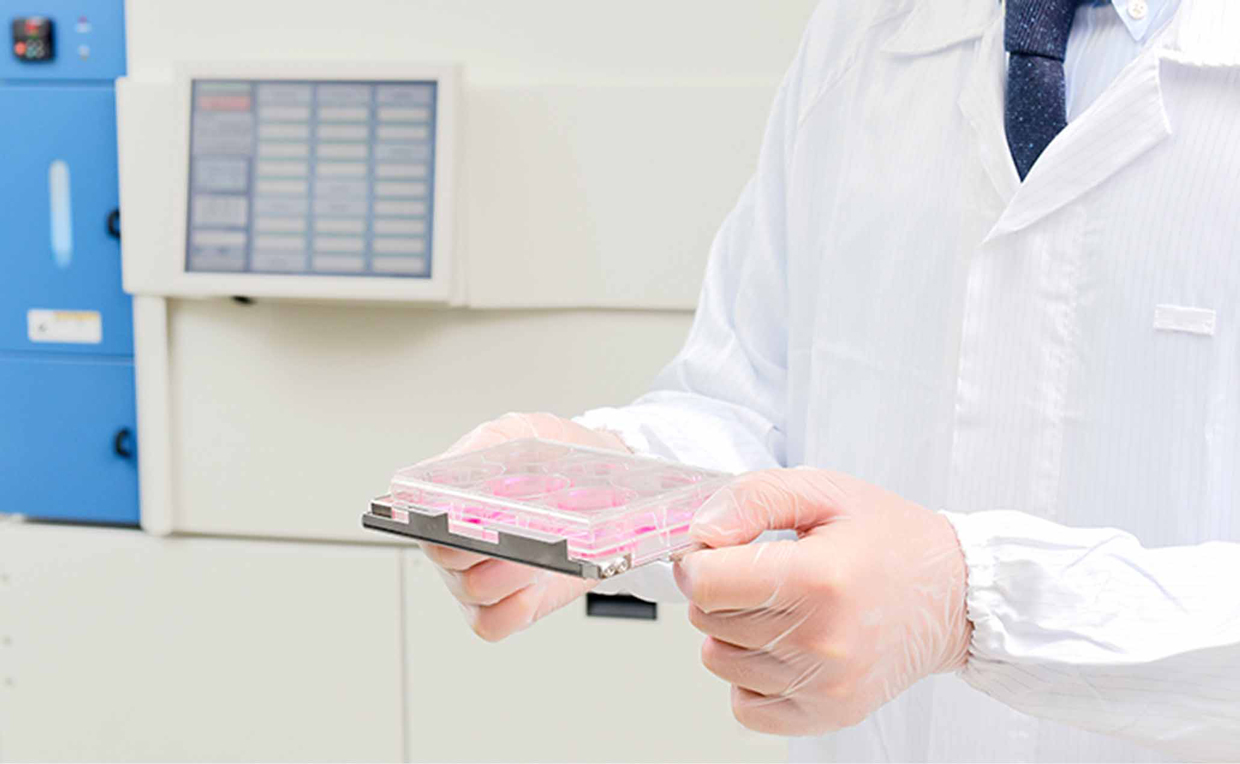Key to practical application of regenerative medicine

Nikon's technologies contribute
to commercializing iPS cell research
Research of iPS cells has now entered a new phase toward its practical application in regenerative medicine, but still faces several obstacles. Nikon's solutions open the door to stable mass production of iPS cells.
iPS cells: cultivating the dream future of medicine

Generated from human skin and blood cells, iPS cells can be differentiated into almost any human body tissues and organs. Once practical application begins, the technology will be able to contribute to various medical areas including nerves, cardiac muscles, internal organs such as the liver and pancreas, cartilage, T cells and the retina. We may be able to regain functions by replacing deteriorated tissues and organs with those developed from iPS cells.
The Center for iPS Cell Research and Application, CiRA for short, at the Kyoto University, leads the world in this field. There, the next level of research — mass production of iPS cells — is under way.
Culturing iPS cells is similar to an agricultural process. First, we seed the original iPS cells in laboratory dishes (seeding) and culture them into colonies (medium change). Once they are mature enough, we can harvest them (passage). Repeating this process, iPS cells can be produced in large quantities.

Obstacles hindering iPS cell mass production

Many obstacles stand in the way of iPS-cell mass production, however.
The quality of industrial products can be maintained by following established manufacturing processes. But each live cell is unique and develops differently. Thus cell culture always requires observation and judging by human eyes.
Another obstacle is the varying skill levels of lab technicians. For example, sowing the cells evenly throughout the dish is important, because having them concentrated in one area more than another hinders their development. Renewing medium and passage require good powers of observation and judgment from technicians as to whether cells have matured sufficiently.

Furthermore, when looked at closely, there is a variety of iPS cells, with some suited for the heart and others ideal for cartilage. They take different shapes and develop in various ways. This also requires practitioners' expertise. Besides differences in each technician's skill level, daily practice and judgment of the same staff member may vary depending on factors such as health.
Cell culturing is an extremely delicate practice. How can we solve these problems and realize stable cultivation for mass production? This will determine the future of regenerative medicine.
Nikon technologies automate the cell culture process

Nikon has been studying the quality of iPS cells during culturing and the cultivation process in collaboration with CiRA. This resulted in the iPS cell quality assay system, that is capable of objective observation, instead of human eye observation that tends to vary.
Since about 2007, Nikon has supported researchers in creating a more ideal observation environment by introducing the BioStation CT that enables microscopic observation of live cell culture and the BioStudio, a microscope that can be placed in an incubator.
The iPS cell quality assay system combines these observation systems and software, inheriting the role of evaluation from the human eyes and brain. It provides a solution for stable, consistent production of cells in greater quantities, without being affected by varying technicians' skills or inconsistent assessment.
Taking a significant step forward toward industrial application of iPS cell technology


Yasujiro Kiyota
Microscope Solutions Business Department
Cells are alive and each of them comes with a different trait. This demands that we accommodate each of their unique characteristics when culturing. Thus, boosting the skill levels of culturing technicians is crucial. Experienced staff members can foresee the success of cultivation at the time of seeding. I'm a living example who has attained such skills thanks to my many years of experience. [laughter]
The iPS cell quality assay system enables evaluation of the cells themselves. But in the future, we want to build upon this and create a platform that integrates management of all the production processes of cells, in addition to this evaluation.
Manufacturing industrial products is usually based on "Quality by Test" principles, in which quality is ensured by end-product inspections. But in cell production, we adopt "Quality by Design" concepts, in which quality is assured by checking production lines. By incorporating quality assay of cells at each step of production, we can create a manufacturing system that confirms all processes have been properly conducted. We want to introduce and share this evaluation system as our standard.
If we can standardize the production process, that incorporates cell assay, on a global scale, iPS cell use may become increasingly common. I believe my mission is to provide people all over the world with high-quality iPS cells as soon as possible.
- *Job title and responsibilities at time of interview.
Originally published: January 10, 2017.





